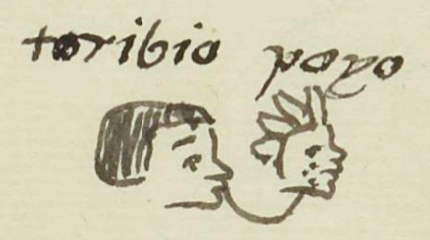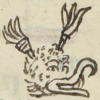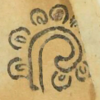Poyon (MH687v)
This black-line drawing of the simplex glyph for the personal name Poyon (either a "Rose-Like Flower" or “A Hallucinogen,” attested here as a man’s name) shows the head of a man in profile, facing toward the viewer’s right. The man’s hair is spiky and he has pock marks or freckles on his face (dots). Perhaps his appearance is suggestive of a priest who consumes hallucinogenic plants, such as poyomatli (or poyomahtli, with the glottal stop). Alternatively, the name may be as glossed, Poyo, short for Poyotl, which means “Evil or Decaying.”
Stephanie Wood
Glyphs for the name Poyon (if indeed the final “n” dropped away inadvertently) can vary greatly. See some examples below.
Stephanie Wood
toribio poyo
Toribio Poyon
Stephanie Wood & Jeff Haskett-Wood
1560
Jeff Haskett-Wood
sacerdotes, chamanes, alucinógenos, flores, nombres de hombres

poyo(tl), evil or decaying, https://nahuatl.wired-humanities.org/content/poyotl
Flor Como Rosa, o Un Alucinógeno
Stephanie Wood
Matrícula de Huexotzinco, folio 687v, World Digital Library, https://www.loc.gov/resource/gdcwdl.wdl_15282/?sp=455&st=image.
This manuscript is hosted by the Library of Congress and the World Digital Library; used here with the Creative Commons, “Attribution-NonCommercial-ShareAlike 3.0 License” (CC-BY-NC-SAq 3.0).









